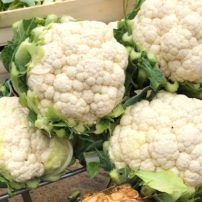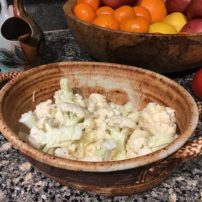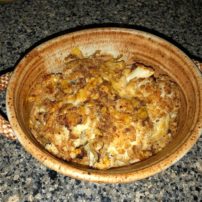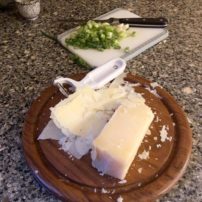If ever a vegetable has caught the attention of dieters and gourmands alike, it is the trendiest of all vegetables in 2020 — cauliflower. Versatile, low in carbohydrates and calories and with a mild and non-distinctive flavor, cauliflower lends itself to an amazingly wide variety of cooking methods. It can be steamed, broiled, grilled, baked, roasted, mashed, grated, riced and even used as a crust for pizza!
A member of the brassica family, cauliflower is loaded with vitamin C and a variety of other nutrients. Most notably, it contains a group of substances known as glucosinolates. It is thought these compounds may help prevent cancer, as they protect cells from damage and have anti-inflammatory, antiviral and antibacterial effects.
These sulphur-containing compounds are found mostly in cruciferous vegetables such as broccoli, kale, cabbage, Brussels sprouts, etc., and are what give these vegetables an offensive odor or bitter taste if old or overcooked. Due to their many health benefits, nutritionists encourage us to eat a portion of this interesting group of vegetables every day.
I grew up in a family where cooking from scratch was the norm for many reasons. I was born in the 1940s and convenience foods, not becoming prevalent until sometime in the late 1950s, tended to be expensive and not very tasty.
My mother was a registered nurse, and she believed the best way to protect her family’s health was to feed us fresh fruits and vegetables. She always bought whatever was in season at the produce market because the prices were much more reasonable there than at the supermarket.
Cauliflower was a regular vegetable on our table in the winter months, because that was when it was being harvested in the Phoenix area. We just always ate it steamed, seasoned with a little butter and salt and pepper, and occasionally drizzled with some cheese sauce. I never paid much attention to it until sometime in the 1980s, when I was a guest at Our Chalet in Adelboden, Switzerland.
Our Chalet is a hostel owned and operated by the World Association of Girl Scouts and Girl Guides, and a place I had dreamed of going since I was a 10 year old junior Girl Scout. When my husband’s job took us to live in England in 1982, I took my longtime involvement in Girl Scouts with me, and through a serendipitous chain of events, landed in Adelboden, celebrating my 40th birthday.
The Swiss cook at Our Chalet, Katie, made sure everything she put on the table was not only nutritious, but also beautifully presented and amazingly delicious. Meals were always served family style, with the platters of food placed at the end of each table of eight guests, and served onto our plates by a staff member seated at our table.
One evening, after a long and arduous hike in the alps, our dinner menu included cauliflower, and the presentation was a feast for the eyes. A large, steaming, snowy-white whole head of cauliflower — with little bits of green leaves peeking out from underneath — sat in a shallow bowl. Sprinkled with strands of freshly grated mountain cheese, dusted with paprika and topped with thin green slices of scallion tops, this vegetable was a sight to behold.
Our server sliced the cauliflower into wedges as one would slice a cake, and placed one on each of our plates, along with a small cutlet, roasted potato and green salad. It was the cauliflower that caught my attention — perhaps because it was cooked to perfection? Or because the interplay between the colors was so appetizing? Or the way the flavors of the local alpine cheese and smoky paprika and green onions danced on my tongue?
I am not sure how this simple vegetable could be so memorable, but I continued to serve it the very same way at home for years to come.
Fast-forward 25 years, and today the humble cauliflower has become a staple on nearly every restaurant menu as well as every diet website. Recipe websites offer dozens of ways to prepare it, far beyond the raw floret of the veggie tray of the ’70s or the soggy, steamed florets of my childhood. Ricing has become very popular, and it can be purchased already riced or done easily at home in a food processor.
In my house, we enjoy cauliflower roasted with other vegetables, sautéed, as a main ingredient in a vegetable curry, puréed and served as a base for a protein dish, in soup or occasionally mashed in place of potatoes.
Winter months are the time to enjoy cauliflower and all of its brassica cousins, as they are cool-season vegetables and at their sweetest peak after a light frost. Available in a rainbow of colors along with a hybrid of cauliflower and broccoli called Romanesco, cauliflower can be a fun and colorful addition to the winter table.
Today’s recipes include steaming a whole head and serving it Swiss-chalet style; and a cauliflower gratin, a nod to my recent cooking school experience in France.
Easy Cheesy Cauliflower Gratin
Ingredients:
- 1 small-medium head cauliflower
- 1 cup nonfat evaporated milk
- 1 tablespoon flour
- Salt and pepper, to taste
- 1 cup shredded parmesan cheese
- 1/4 cup coarse bread crumbs
- Smoked paprika
Instructions:
Preheat oven to 350 degrees.
Cut away leaves and stems and break cauliflower into flower-ettes. Place pieces in baking dish and sprinkle with flour.
Sprinkle with shredded cheese and pour milk over all. Mix well. Cover tightly with aluminum foil and bake about 30 minutes until tender.
Remove foil, sprinkle with bread crumbs and cheese. Dust with paprika for color.
Bake uncovered for 10 minutes or until cheese is melted.
Steamed Cauliflower ‘Swiss Style’
Ingredients:
- 1 medium-large head cauliflower
- 2-3 fresh scallions, thinly sliced, including tender green parts
- 1/4 cup shaved parmesan or asiago cheese
- Paprika
Instructions:
Leaving green leaves around the bottom of the cauliflower, carve a cone-shaped piece out of the stem of the head. Place in a steamer basket in large pot over a couple inches over simmering, salted water.
Cover and steam 15-20 minutes until the cauliflower is tender, but not soft. Remove from steamer, place in a large, shallow bowl.
Sprinkle with Parmesan shavings, then scallions, and dust with paprika.
Present on the table as a whole head, and slice into wedges. Sprinkle with salt and pepper as desired.



































